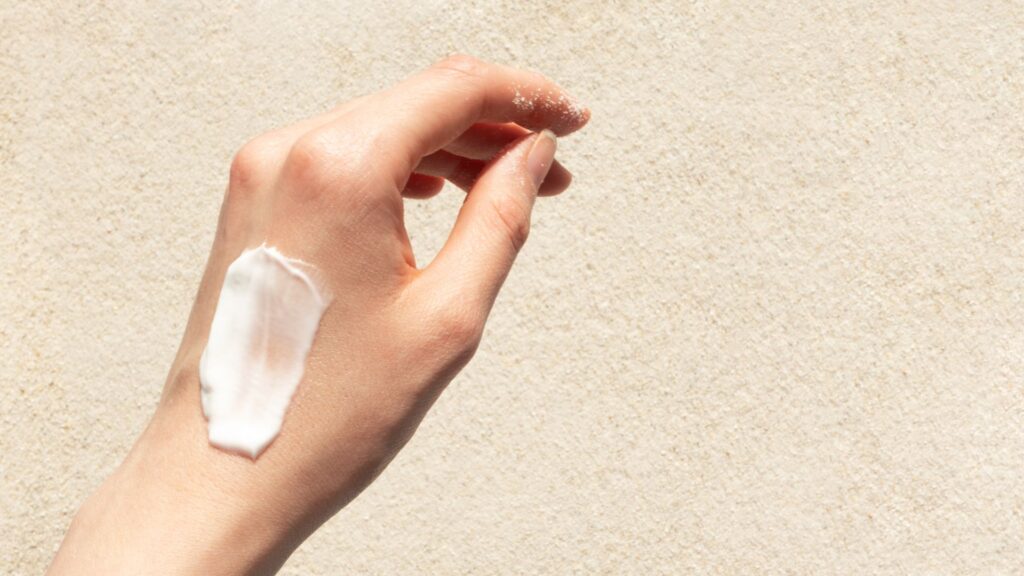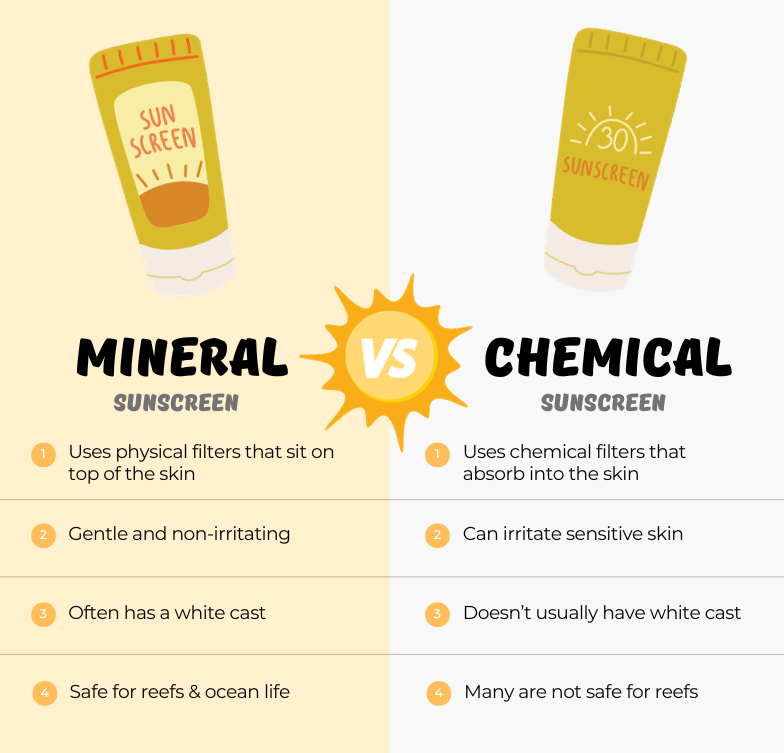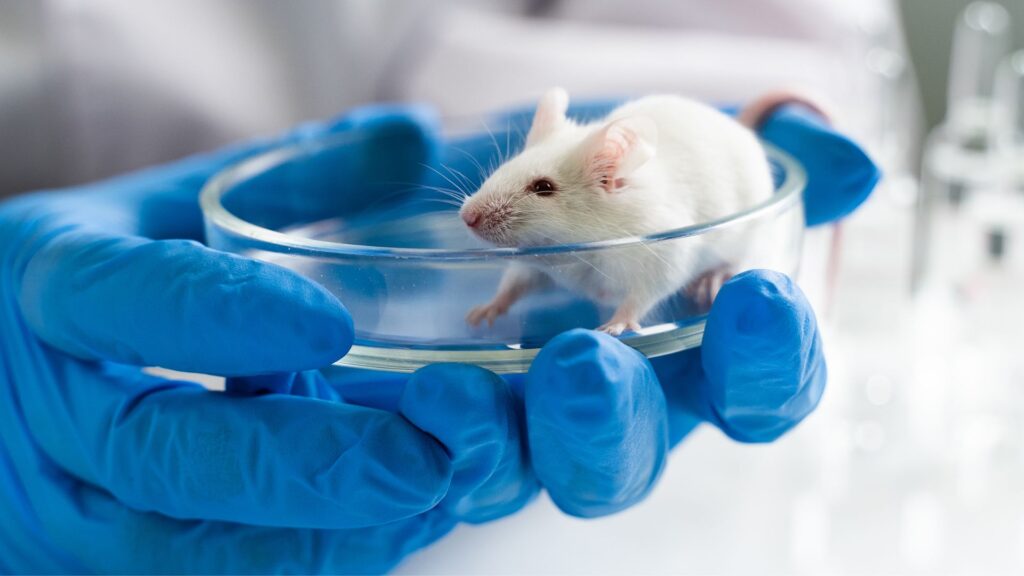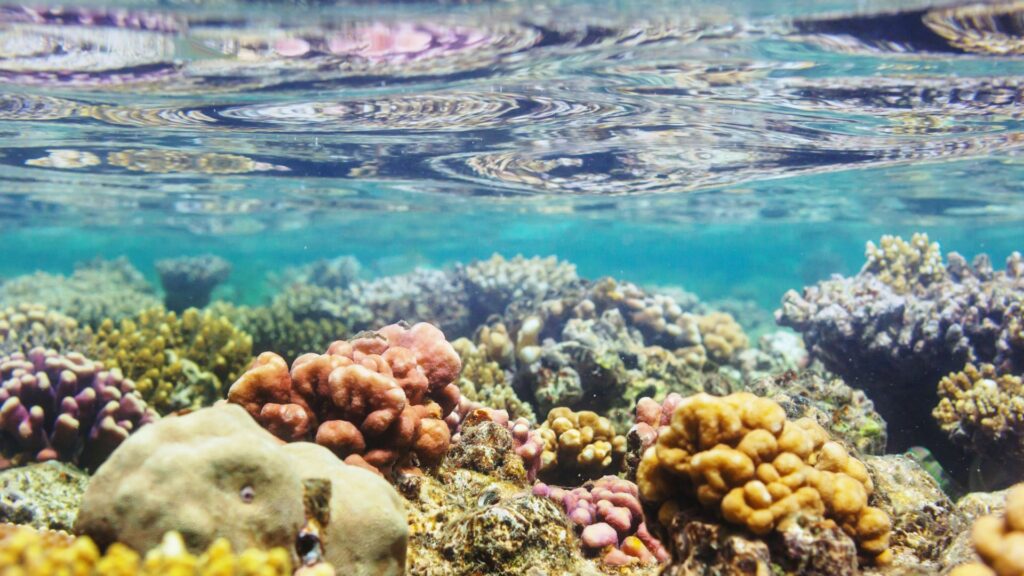Ah, oxybenzone. It’s a common ingredient in many sunscreens and acts as our bodyguard against damaging UV rays.
Yet, a growing chorus of discussion raises concerns about its potential impacts on human health and the environment. So, what’s the deal?
Let’s be clear right off the bat—this isn’t a black-and-white issue.
The evidence regarding its safety is mixed with conflicting studies, often adding to the confusion. So today, we’re getting to the bottom of things.
We’ll be delving into its role in sunscreens, examining potential health impacts, and shedding light on any environmental issues linked with its use. Taking a close look at the research, we’ll separate fact from fear, so we can make an informed choice about whether or not oxybenzone belongs in our sunscreen.
So, let’s go ahead and dive into this hot topic. Shielded by the same sunscreen that’s at the center of our inquiry, we’re ready to dig into the facts.
What is Oxybenzone, Anyway?
Kick-starting our quest into the world of oxybenzone, let’s start with what it is.
Oxybenzone is an organic compound that’s a member of a group called benzophenones, responsible for filtering ultraviolet rays.

This nifty compound works by absorbing harmful ultraviolet radiation from the sun and converting it into less harmful heat. It helps shield your skin from the damaging effects of the sun, preventing both painful sunburns and dangerous skin cancer.
Oxybenzone first appeared on the sunscreen scene around the 1970s, promising to deliver superior, broad-spectrum protection against both UV-A and UV-B rays.
This is because of its ability to absorb a wider range of UV wavelengths.
The result?
Sunscreens that cover you from more of the sun’s harmful UV spectrum.
Sure enough, oxybenzone found its way into a sea of sunscreen products, from lotions and sprays to sticks and lip balms—turning them into our summer essentials.
Plus, it comes with a few more brownie points such as stability (it’s resistant to degradation when exposed to sun), low cost, and it’s relatively easy to formulate—making the sunscreen market fall head over heels!
How Are Oxybenzone Sunscreens Different From Physical Mineral Sunscreen?
Chemical sunscreens, which include UV filters like oxybenzone, are absorbed into the skin and then absorb UV rays, convert them into heat, and release them from the body.

On the other hand, physical (or mineral) sunscreens, like titanium dioxide or zinc oxide, act as a physical barrier on the skin’s surface, reflecting or scattering UV radiation.
Since physical mineral sunscreens don’t absorb into the skin, they are much thicker and don’t usually spread as smoothly and easily across the skin (although newer formulations are making strides in this area).
Chemical sunscreens that use ingredients like oxybenzone were a real boon when they entered the market because they absorbed into the skin much easier than the thicker existing zinc oxide sunscreens. They go on smooth and don’t leave an annoying white cast on the skin.
Is Oxybenzone Friend of Foe: Breaking Down Rumors & Resarch
Despite its UV-fighting prowess, oxybenzone has been at the center of a sunscreen drama.
The reason?
Its potential risks.
The FDA has been playing hot potato with oxybenzone regulations, and currently, it falls under Category III, which is code for “we’re not sure if it’s safe.”
The FDA has noted that oxybenzone is absorbed through the skin to a greater extent than they previously understood and “is a concern, among other reasons, because of questions raised in the published literature regarding the potential for endocrine activity”
But the jury really seems to be out on whether or not oxybenzone is worth worrying about, as scientific studies present a mixed bag of findings.
We’ll do our best to separate myth from fact due to the research we’ve done regarding existing oxybenzone studies in the rumor documented below!
Rumor #1: Oxybenzone can be absorbed into the blood (true!)
A lot of major concern around oxybenzone comes from the fact that multiple studies done by the FDA have shown that oxybenzone (along with other chemical sunscreen ingredients) can penetrate the skin and seep into the bloodstream.
This is true – oxybenzone can be absorbed into the body.
It’s been found in the bloodstream of exposed individuals and has even been found in urine and breast milk.

In fact, the Centers for Disease Control and Prevention found that oxybenzone can be found in the urine of nearly all Americans!
This may sound ominous, but there isn’t any proof yet that these chemicals are necessarily dangerous. The truth is that a lot of toxic chemicals from our clothing and environment seep into the skin and can be found in the bloodstream – including PFOAs, microplastics, and pesticides.
This isn’t to say that this is good or normal. But it does seem to be a sad reality of modern life today.
Rumor #2: Oxybenzone in sunscreen is responsible for numerous health issues (false)
You may have heard that oxybenzone exposure can affect your hormone, kidney, and thyroid function. But a 2020 research review in the International Journal of Dermatology found no conclusive evidence that either oxybenzone or octinoxate causes health issues.
The study did note that oxybenzone exposure is associated with changes to your hormone, kidney, and thyroid function – but there isn’t enough evidence to establish a cause and effort.
Especially due to the fact that oxybenzone exposure isn’t just the result of sunscreen – it can be due to the use of other cosmetics and personal products including hair spray, nail polish, and certain plastics.
Rumor #3: Oxybenzone may increase a fetus’s risk of Hirschsprung’s Disease (true)
Research published in Reproductive Toxicology found that pregnant women with medium to high levels of oxybenzone in their urine were associated with giving birth to babies with a birth defect called Hirschsprung’s Disease (HSCR).
This is a rare disease, affecting an infant’s large intestine. It occurs in one out of 5,000 children and may require surgery.
While this is troubling, it’s important to remember that the study is very dose dependent and can be affected significantly depending on your climate.
Where you live and how often you apply sunscreen are major factors affecting a fetus’ risk for Hirschsprung’s disease. For example, your baby may have a higher risk factor if you live in a warm and sunny year-around location that requires daily sunscreen use vs someone who lives in a more variable climate and only uses chemical sunscreens daily when on vacation.
Rumor #4: Oxybenzone is a hormone disruptor and causes uterine growth (true – kind of)
One of the biggest strikes against oxybenzone is that it is reported to behave like a hormone disruptor. A hormone disruptor is a chemical that can cross cell membranes and has the potential to affect your body’s normal hormone production.
And evidence shows that this may be true – to a degree.
It’s true that one study found uterine growth in rats who were exposed to oxybenzone. But, as always, it’s important to observe how the study was performed.
The rats in this study didn’t have oxybenzone just exposed to their skin – they were fed the chemical, and were given a huge amount over the course of four days.

In order to mirror this study in humans, it would take an individual 277 years of sunscreen use to achieve the equivalent systemic dose the rats experienced. It’s not really an appropriate or accurate model of how a human would be exposed to oxybenzone.
But there’s other evidence that seems to speak to oxybenzone’s danger as a hormone disrupter.
Researchers examined a collection of CDC data evaluating American children’s exposure to oxybenzone and found that adolescent boys with higher oxybenzone measurements had much lower total testosterone levels.
Rumor #5: Oxybenzone causes skin allergies (sometimes true)
Oxybenzone has been known to cause allergic reactions in some people.
This isn’t all that common though.
What is much more common is skin irritation, and oxybenzone does seem to be a fairly regular culprit of that if you’re an individual with sensitive skin.
Rumor #6. U.S. sunscreens contain unsafe amount of oxybenzone: (true, according to Europeans)
Well, it really depends on who you ask. Europeans seem to feel U.S. sunscreens contain too much oxybenzone. But Europans have more stringent guidelines than the US across many consumer products, especially when it comes to food.
A 2021 report from the European Commission’s Scientific Committee on Consumer Safety noted that concerns about oxybenzone’s hormone disrupting properties are “not conclusive.”
However, they said that products should only be considered safe if oxybenzone makes up a maximum of 2.2% of their formula.
And U.S. sunscreens? They can contain up to 6% oxybenzone.
Rumor #7: Oxybenzone causes skin cancer (very false)
There is absolutely zero evidence that any sunscreen or sunscreen ingredients cause skin cancer. These are baseless rumors and there is no data to support any kind of link between sunscreen and skin cancer.
For example, some people may become convinced they developed skin cancer due to sunscreen, since they developed skin cancer after regularly using sunscreens. Not only is this not causation, but it’s also very likely that the skin damage as a result of sun exposure in childhood or earlier years, before the individual regularly usd sunscreen, is responsible for skin cancer.
Remember, childhood sunburns can have a dramatic effect on one’s long-term risk of skin damage.
The American Academy of Dermatology notes that suffering five or more blistering sunburns between ages 15 and 20 increases one’s melanoma risk by 80% and nonmelanoma skin cancer risk by 68%.
Rumor #8: Oxybenzone Damaged Coral Reefs (true)
Laboratory-based research suggests that oxybenzone may contribute to coral bleaching, which involves the loss of algae from the coral, leading to the reef’s eventual death.
Research, notably a 2016 study published in the Archives of Environmental Contamination and Toxicology, found that oxybenzone is toxic to the symbiotic algae living within corals even at low concentrations.

Oxybenzone has been found to cause coral bleaching, inhibit coral growth, cause deoxyribonucleic acid (DNA) damage, and disrupt endocrine functions in coral larvae and cells, leading to deformities and a reduction in their ability to reproduce.
This research has sparked deliberations regarding whether oxybenzone and other similar chemicals should be phased out from consumer products to protect marine ecosystems.
Thankfully, many chemical sunscreens already have begun altering their formulas to avoid oxybenzone.
Pessimistically, we might say this is due to the marketing effects of being able to put “reef-safe” on the sun screen’s bottle – although there is some evidence to suggest that alternative chemical filters like avobenzone aren’t proven to be safe for coral reefs either.
Picking the Right Sunscreen: No PhD Required
With all this information, choosing sunscreen can feel like a game of Russian roulette.
But, this absolutely does not mean you should ditch sunscreen altogether – it’s not hard to pick a safe sunscreen and limit your oxybenzone exposure.
The Biggest Tip? Opt for a Mineral Sunscreen
If the oxybenzone controversy has you second-guessing, don’t fret!
You can avoid oxybenzone altogether but just opting for a mineral-based sunscreens that contain zinc oxide or titanium dioxide.
These mineral sunscreens contain no chemical filter and no oxybenzone. And nearly all mineral sunscreens are reef-safe too! They’re also the go-to sunscreens for anyone with sensitive skin that can be easily irritated by chemical filters.
Other Tips:
- Choose an EWG certified sunscreen. The Environmental Working Group (EWG) certifies sunscreen products that meet rigorous standards including ingredient safety and efficacy. Picking an EWG certified sunscreen ensures you’re choosing a product that is both skin- and eco-friendly.
- Avoid chemical sunscreen if you’re pregnant. We don’t know the implications of its use in women who are pregnant or breastfeeding, because that type of clinical study can’t be performed on this group. So, out of an abundance of caution, use a zinc- or titanium-based sunscreen if you’re pregnant.
- Know what works for your skin. Not all sunscreens are created equal, and everyone’s skin responds differently. It’s crucial to choose a product that doesn’t irritate your skin or cause an allergic reaction.
- Always opt for broad-spectrum. Broad-spectrum sunscreens protect against both UVA and UVB rays. UVB rays cause sunburn, while UVA rays can prematurely age your skin. Both contribute to skin cancer, making it essential to choose a broad-spectrum sunscreen.
- Reapply regularly. Sunscreen needs to be reapplied every two hours, or immediately after swimming or sweating excessively, for maximum efficacy. Even water-resistant sunscreens will diminish over time.
- Use sun hats and UPF clothes, too. Supplement your sun-care routine with clothing designed to protect against UV rays. Wide-brimmed hats can shield your face and neck, and clothes with a Ultraviolet Protection Factor (UPF) rating will help block UV radiation.
- Avoid oxybenzone chemical filters. If you prefer the ease of application and light feel of chemical sunscreens, you can simply seek out sunscreen with no oxybenzone and opt for avobenzone instead. There’s no guarantee avobenzone is better, but there is no existing research saying it shares the same potential risks of oxybenzone.
It can be scary seeing all this mixed info about oxybenzone and chemical sunscreens.
But remember – chemical sunscreen ingredients have been around for decades, and there’s been no evidence that these ingredients have caused significant health issues for most of the population.
And ultimately, we don’t really know if oxybenzone is a dangerous substance. But we DO know how dangerous sun exposure without sunscreen is.
Luckily, if you’re concerned about chemical sunscreens, physical mineral sunscreens offer a great, known-to-be-safe alternative.
In the end, the best sunscreen is the sunscreen you’ll actually wear. If you hate mineral sunscreens and can’t stand the white cast, we still think chemical sunscreens are worth the risk.
Skin cancer is no vague, yet-to-be-researched risk. It’s real, it’s common (according to our skin cancer facts, it’s the most common type of cancer), and it’s deadly.
So, what’s your take on oxybenzone? Have you sworn off chemical sunscreens, or do you make exceptions from time to time? We’d love to hear your thoughts!

